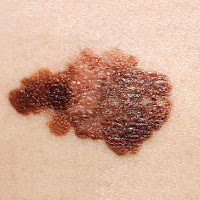 |
Melanoma lesion. Do bacteria contribute to
our skin cancer defences? |
Research into (and clinical and commercial exploitation of) our bacterial travelling companions has so far largely focused on the relationship between gut dwellers and health. As the largest organ of the body (at between 6% and 10% of total body weight), and with the function of keeping the inside safe from the outside, it’s perhaps not surprising that human skin has evolved a rich and complex microbiome which can influence the course of disease.
In common with Planet Earth as described in the “Hitchhiker’s Guide to the Galaxy”, skin bacteria are “mostly harmless”, although physiological changes can make us susceptible to blemishes and rashes caused largely by Staphylococcus aureus and, that bane of teenagers, Propionibacterium acnes. Skin bacteria in the wrong place (the blood stream, newly-replaced hip joints) are always bad news.
But, by and large, the skin microbiome functions well to keep potential pathogens in check through a variety of mechanisms, including production of selective antibacterial agents and the downregulation of inflammation. One of the most studied of these “good guy “bacteria is Staphylococcus epidermis. Collaboration between researchers at the University of California, San Diego, and other institutes has uncovered a possible association between certain strains of S.epidermis and suppression of the skin cancer, melanoma.
While attempting to better characterise the selective antibacterial activity of S.epidermis, the UCSD group identified a strain producing 6-N-hydroxyaminopurine (6-HAP), a suppressor of DNA synthesis. S.epidermis 6-HAP was established to be non-toxic, with no evidence of the mutagenic effects associated with chemically-synthesised 6-HAP. When tested in the laboratory, 6-HAP was active against squamous cell carcinoma and melanoma cell lines, and to a lesser extent, lymphoma cells.
Systemic treatment of mice in which human melanoma tumours had been established with 6-HAP resulted in a 60% reduction in tumour size, while colonization of the skin of mice with the 6-HAP-producing S.epidermis strain significantly reduced the occurrence of UV light-induced skin cancer over mice identically treated with a non-6-HAP-producing strain.
Early days, but this does raise the possibility that in addition to their established “anti-pathogen” role, S.epidermis and possibly other commensal skin bacteria might actively contribute to tumour suppression through early elimination of transformed cells. The 6-HPA-producing strain appears to be common “in the wild” and epidemiological studies might perhaps someday establish an association between 6-HPA producers (or their absence) and melanoma prevalence.
The UCSD researchers are hopeful of exploiting their findings through a start-up company, MatriSys Bioscience, with the notion of restoring or modifying the skin microbiome. Effecting colonization with a 6-HAP-producing S.epidermis strain could conceivably reduce susceptibility to melanoma and other skin cancers, but given the multifactorial nature of cancer, it’s not something that will be easy to establish in the context of clinical studies. Nevertheless, the UCSD study does underscore that outer microbiome research has an importance beyond better treatments for eczema and acne.
Photo credit: NCI
A commensal strain of Staphylococcus epidermidis protects against skin neoplasia. Nakatsuji, T et al. Sci. Adv. 2018; 4: eaao4502 Online 28th February 2018. http://tinyurl.com/y7o699ez
"Mostly Harmless. A small, blue-green world in one of the less fashionable sectors of the galaxy. It was demolished by the Vogons in order to make way for a hyperspace bypass". Entry for The Earth in "The Hitchhiker's Guide to the Galaxy" by Douglas Adams.

No comments:
Post a Comment